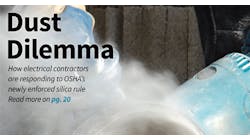Technological advances in high-performance lighting increase lighting efficiency and provide designers with several new lighting options
“Efficiency” continues to be the buzzword in the lighting industry, and as its use continues to grow, the lamps used to meet its demands continue to get smaller. The smaller-is-better trend has been particularly evident in the fluorescent lamp market as manufacturers have consistently decreased sizes since the days of the standard T12 lamp.
The newest family of linear fluorescent lamps is the T5 line of lamps, which consists of standard and high-output (HO) T5 lamps. The standard T5 lamp was developed in Europe several years ago, and then introduced to the North American market in 1996. While some lighting designers began specifying the T5 luminaires immediately, market penetration wasn't great; one reason being that both the lamp and ballast were, and still are, more expensive than T8 systems. Then in 1998, the T5 HO lamp was introduced to the North American market, offering about twice the lumen output in the same length.
Like T8 lamps, straight-tube T5 lamps are available in nominal 2-, 3-, 4-, and 5-ft lengths. The 4-ft T5 lamp is actually 45.8 in. long from pin end to pin end. Generally, the standard T5 lamp and electronic ballast system has light output and efficacy comparable to a T8 lamp/electronic ballast system (Table).
Similar to T8 lamps, the T5 is available in correlated color temperatures of 3,000°K, 3,500°K, and 4,100°K. While T8 lamps are available with a color-rendering index (CRI) of 75 or 85, all T5 lamps have a CRI of 85 or 82, depending on the manufacturer.
While the standard T5 and T5 HO are the same diameter and length, the 4-ft T5 is rated at 2,900 lumens, similar to the lumen per watt output of a T8 lamp. On the other hand, the 4-ft T5 HO lamp is rated as high as 5,000 lumens, offering twice the maintained light output of a T8 lamp. This means that on some projects a designer can use fewer fluorescent fixtures or lamps, thus providing certain savings on installation and long-term maintenance.
With a mini bi-pin base and a .625-in. bulb diameter, the T5 lamp lends itself to low-profile fixtures, such as those used for cove lighting and display cases. The thinness and high lumen output of the lamps also allow for sleeker indirect and direct/indirect pendants and shallower profile recessed troffer-type luminaires.
A variety of new fixture designs take advantage of the T5 lamp's dimensions and other characteristics; thus, these fixtures distribute the lumen output uniformly and achieve a good brightness ratio across the ceiling. With conventional T8 or T12 indirect fixtures, good uniformity can only be achieved by suspending luminaires 24 in. or more from the ceiling (Photo on page 30). In a typical office with a low ceiling, the bottoms of the fixture would hang below 7 ft, which isn't allowed by building codes. But the T5 lamp allows the fixture to be smaller, the optics of the reflector to be more precise, and the suspension to be as little as 15 in.
Because the T5 lamp is only available in metric dimensions, and since it can't be easily retrofitted into existing T8 or T12 fixtures, the T5 lamp family is generally not misapplied.
Lamp and ballast characteristics
The ballasts for the entire T5 family are unique for a number of reasons. This is the first linear lamp type to be served only by electronic ballasts. Within the standard T5 line, a single ballast model can power either one or two standard T5 lamps of any wattage (14W, 21W, 28W, or 35W), since all lamps in the T5 line operate at the same current (170 mA). Additionally, all of the lamp wattages have the same surface brightness, so regardless of the length of the lamp in a cove application, the perceived brightness is uniform.
As mentioned above, with power ratings of 24, 39, 54, and 80, the T5 HO lamp produces as much as twice the lumen output of the standard T5 lamp, and nearly twice the light output of a T8 or T12 system. Each HO lamp requires its own dedicated ballast model. Providing from 83 to 94 lumens per watt, the T5 HO lamps are about 10% to 15% less efficacious than standard T5 lamps and as much as 8% less efficacious than a T8 system. A number of T5 HO ballasts have features, in addition to a dimming function. For example, one model can operate one, two, three, or four F54 lamps, while allowing remote mounting and a high-low switching option.
Temperature is a consideration
One result of enclosing a smaller lamp with a relatively high output in a smaller fixture is heat — and lots of it. For that reason, the T5 lamp provides peak light output at 35°C (95°F) air temperature, whereas the T8 and the T12 lamp provide peak light output at a 25°C (77°F) ambient air temperature. Thus, in an indirect luminaire, where there is little or no air circulation, the T5 lamp can have a higher lumens-per-Watt efficacy than a T8 lamp of about the same wattage because of this thermal characteristic.
Temperature can also come into play as a lamp ages. Because of the lamp's small diameter and high-frequency operation, temperatures can rise at the lamp base ends as the lamp nears end of life because cathode emission material is depleted. This can cause a rise in voltage and result in cracking in the bulb wall. For this reason, all T5 ballasts have what is called “end-of-life circuitry.” This feature shuts off power to the lamp when the ballast senses a rise in voltage across the lamp.
Another important advantage of the T5 lamp is its low mercury content. The lamp has a coating on the inside of the glass wall that stops the glass and phosphors from absorbing mercury. This barrier coating drastically reduces the amount of mercury needed from approximately 15 mg to 3 mg per lamp. Minimizing the amount of mercury also brings another very important advantage: since mercury absorption causes the lamp's light output to depreciate over its life, the coating helps to keep light levels much closer to initial output. The T5 lamp has only 5% depreciation in the first 40% of life (Figure on page 32).
It's easy to see that both the T5 and T5 HO lamps have increasing uses in both office and industrial applications. Now readily available, the T5 HO systems are a viable option for virtually any application with ceiling heights higher than 15 ft, including warehouses, industrial buildings, and gymnasiums. Compared to a conventional 400W metal halide system, T5s offer energy savings of nearly 53%, assuming equal hours of operation. Additional savings are possible where occupancy-based switching is used.



